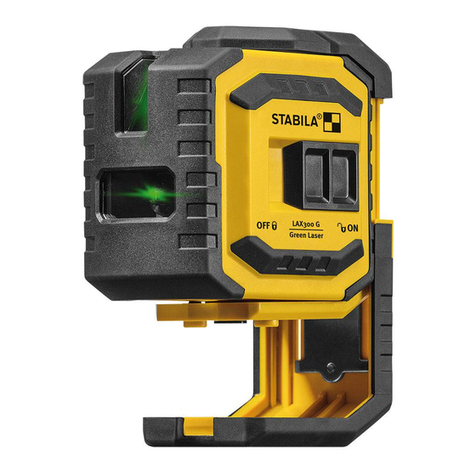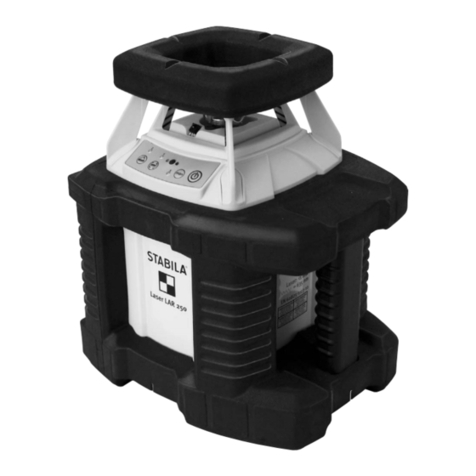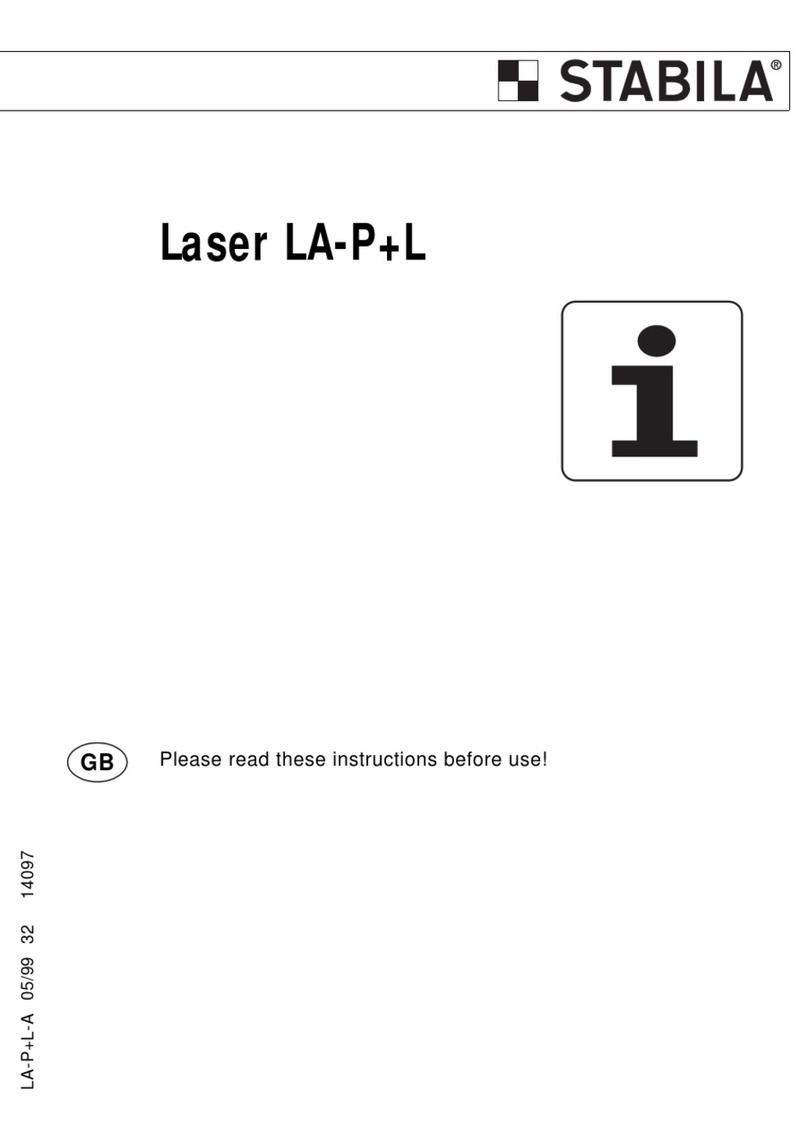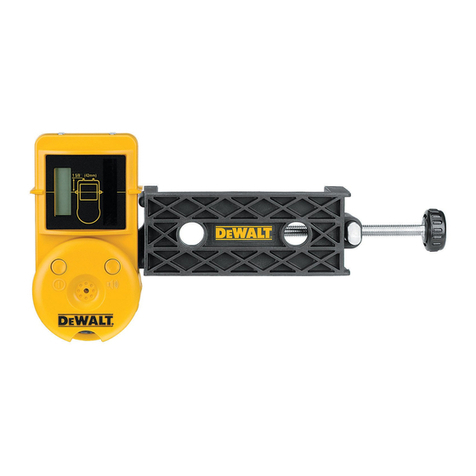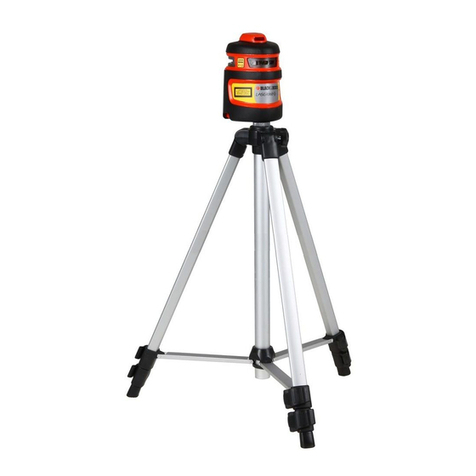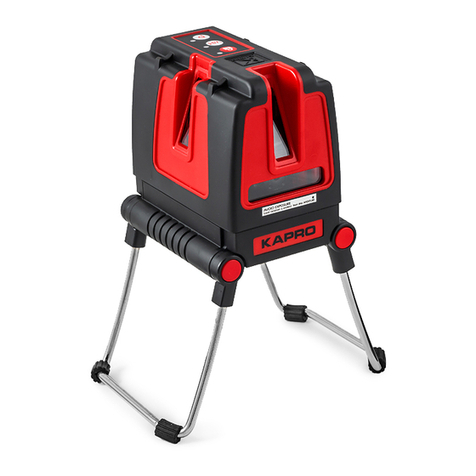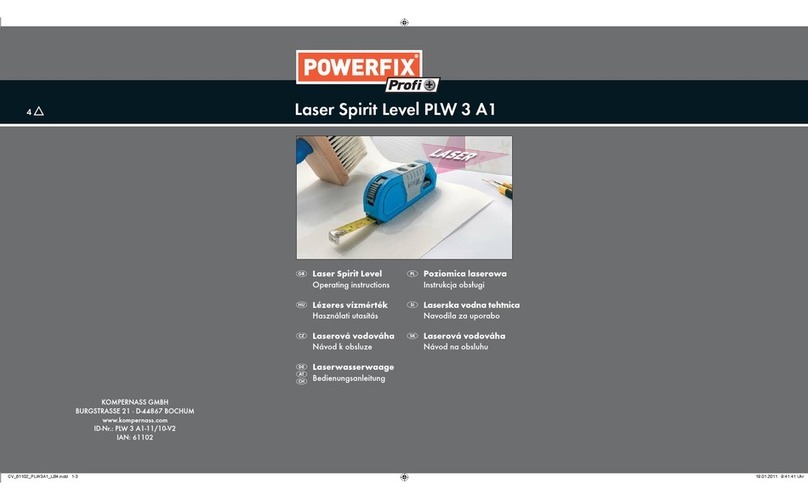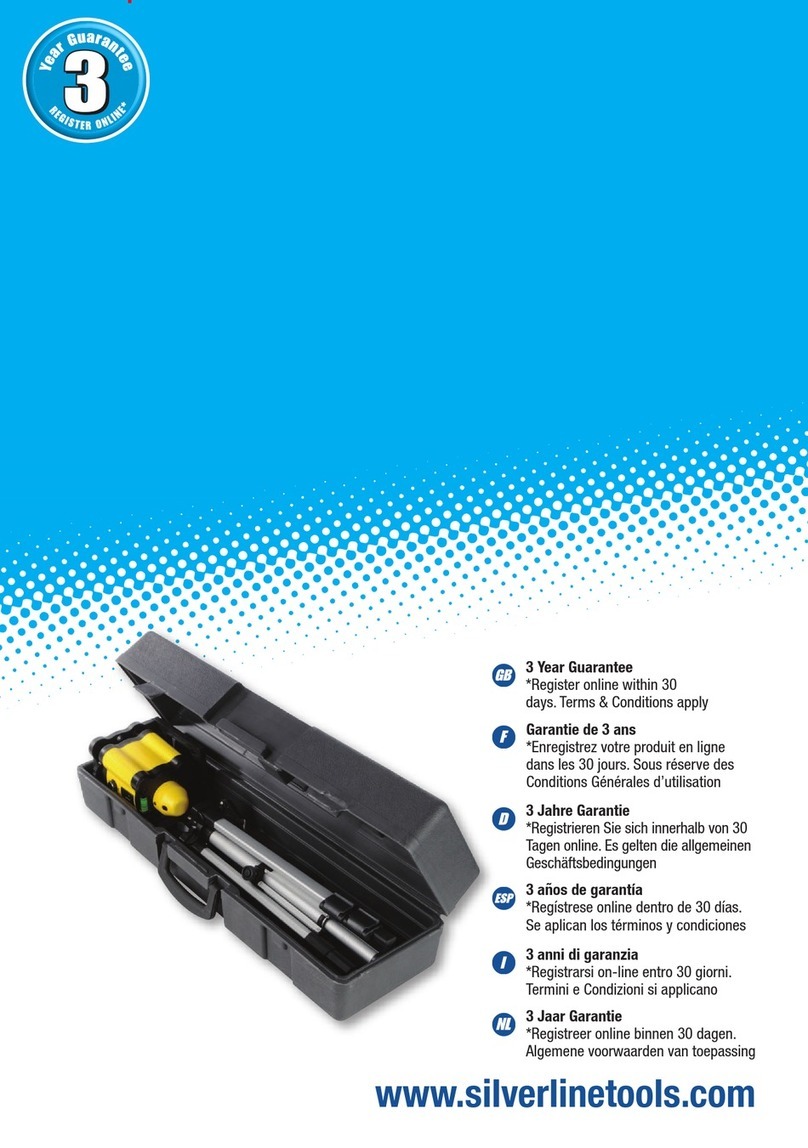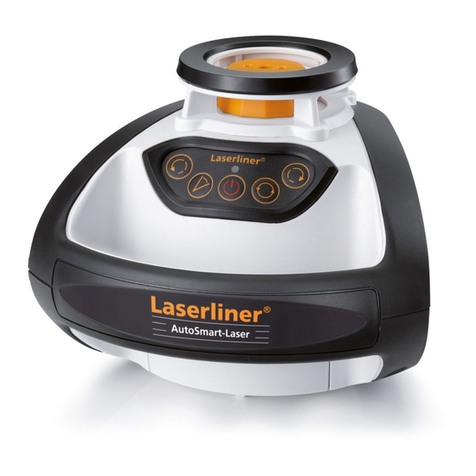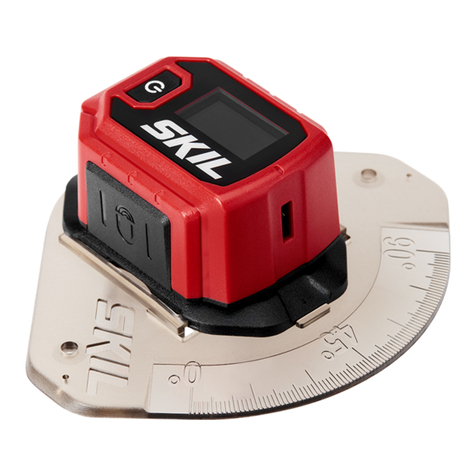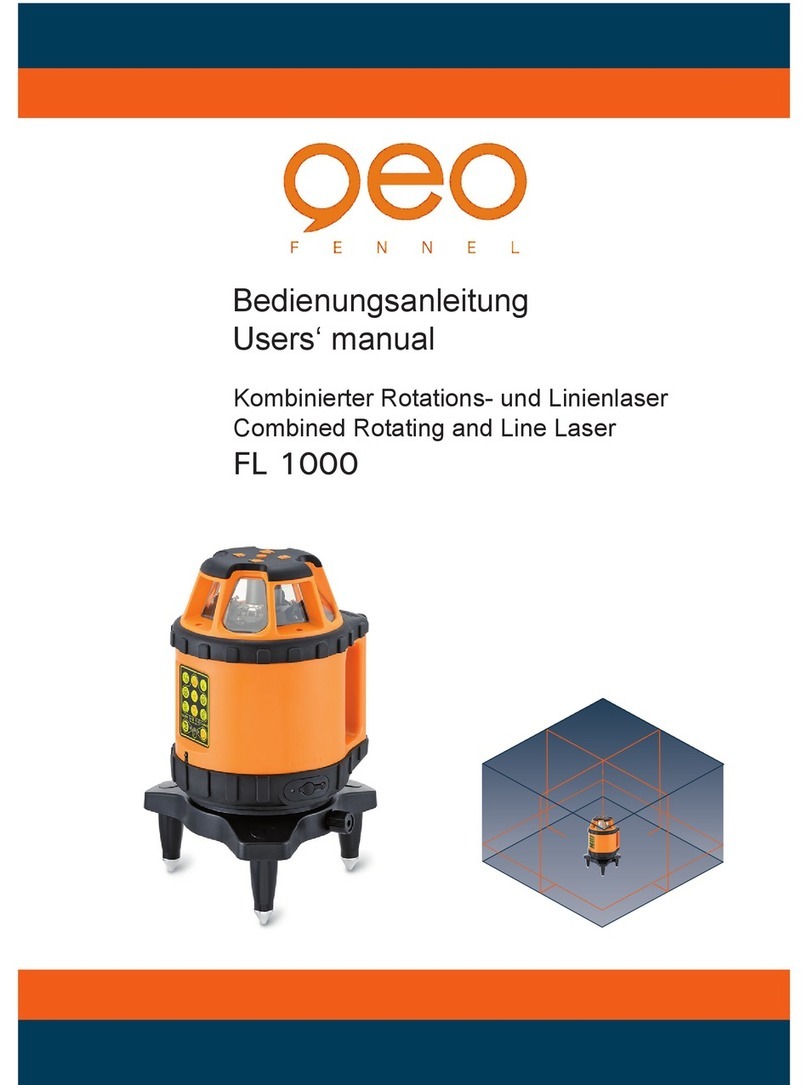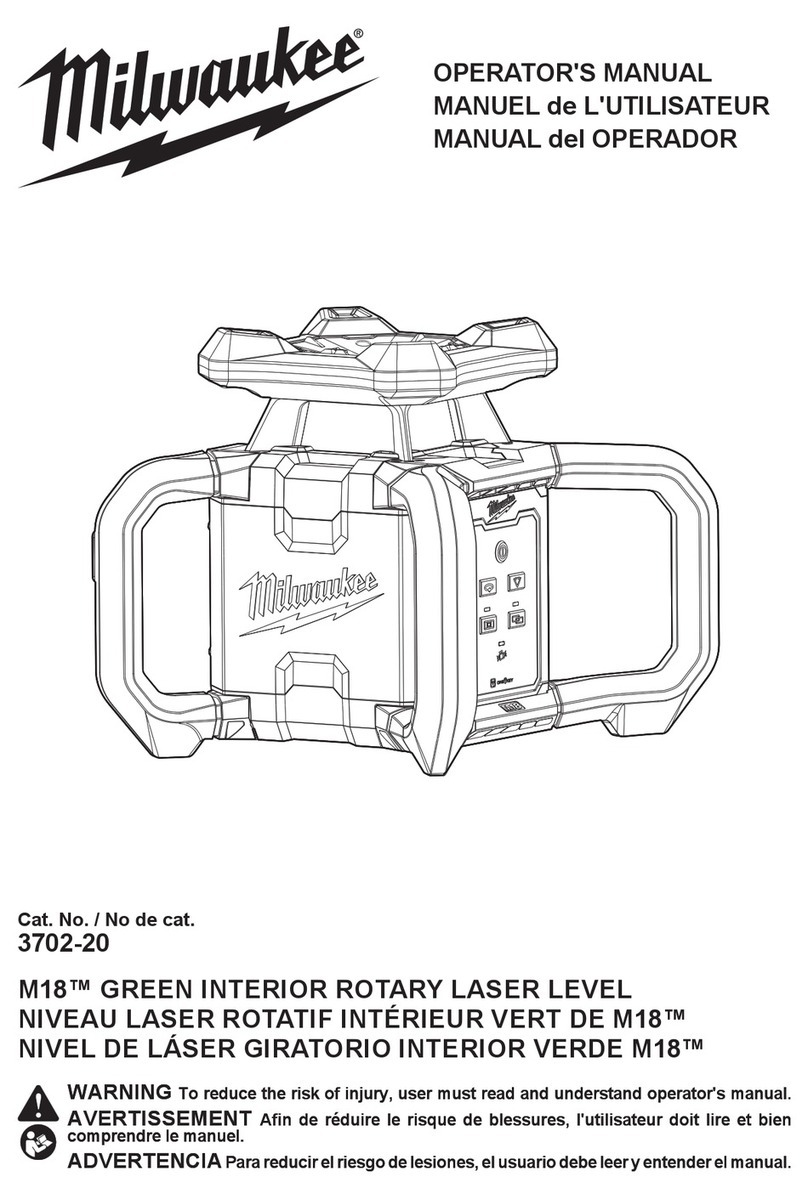Stabila Laser LAR 120 G User manual

Laser LAR 120 G
Operating instructions
en
www. .com information@itm.com1.800.561.8187

A
2
3
7
6
12
11
1
13
8
5a
4a 4b
10
5c
4c
14
15
5b
9
www. .com information@itm.com1.800.561.8187

F
C
B
ED
G
www. .com information@itm.com1.800.561.8187

H
IK
LM
s
17ft 34ft
~ 17ft
www. .com information@itm.com1.800.561.8187

SP1: vertical beam emission aperture
SP2: rotation beam emission aperture
ON/OFF switch
Permanent adjustment On/Off selector switch
Selector switch for bending the laser beam in one axis
LEDs for displaying:
Red LED: battery voltage and overheat
Shock protection
5/8“ threaded connector for tripod
Fine-tuning clamp
Height-adjustment finger hold
Safety and guide clip
Eye for hanging up
Battery compartment cover
0049 / 63 46 / 3 09 - 0
Automatic levelling On/Off selector switch
Main components
The STABILA LAR 120 G rotation laser is an easy to operate rotation laser
for horizontal and vertical levelling and plumb lines. It is self-levelling in
a range of ± 5°. The laser beam can be received at distances of up to 150 m
with the use of a receiver, even when it is no longer visible to the naked eye.
We have endeavoured to explain the unit‘s handling and functioning in as
clear and comprehensible manner as possible. If, however, you still have
any unanswered questions, we should be pleased to provide advice over
the telephone at any time on the following telephone number:
Operating instructions
Splitter pentaprism SP:
(4a)
(4b)
(4c)
Feet for vertical levelling
Targeting marks
(1)
(3)
(2)
(5a)
(5b)
(5c)
(6)
(7)
(8)
(9)
(10)
(11)
(12)
(13)
(14)
(15)
A
4 markings to create a plumb-line laser function
Green LED: Operating mode ON or READY / OK
en
www. .com information@itm.com1.800.561.8187

Before initial start-up :
The warning notice in your language must be clearly axed on the laser
instrument at the position indicated. The appropriate stickers are enclosed.
Familiarise yourself with the laser equipment and all accessories of the
class 3R laser instrument.
Further information can be found at www.stabila.de .....
Read the Operating Manual carefully.
Observe the safety measures.
This sticker with the warning notice written
in the usual language must be axed
here in place of the English text !
www. .com information@itm.com1.800.561.8187

Safety measures which must be observed
Observe the appropriate country-specic safety measures for users
of laser class 3R equipment.
Laser class 3R laser equipment is potentially hazardous to eyes.
Use of operating and adjustment equipment and procedures other than those
indicated here can lead to dangerous exposure to radiation. Modication of
the laser equipment is not permitted. This Operating Manual must be retained
and passed to the next owner of the laser equipment.
Personal safety precautions
This laser equipment may only be used by properly trained persons.
Do not aim the laser beam at people.
If the laser beam falls directly on your eye, consciously close your
eyes and move your head out of the beam immediately.
Do not look into the direct or reflected beam.
Persons under 18 years of age must not use this equipment.
Safety measures to be applied in areas where the equipment
is used:
Ensure that no-one can look directly into the laser beam:
- Mark out the area where this laser equipment is used by means of barriers
and warning signs etc.
- Avoid accidental reflections, for example by covering or removing reflective
surfaces in the vicinity of the laser equipment.
- Position / align the laser beam well away from eye height
- Restrict the laser beam to the area where it is to be used, for example by
screening with non-reflective surfaces
- When not in use, store the laser equipment so that it cannot be accessed
by unauthorised persons
THIS PRODUCT COMPLIES WITH
THE APPLICABLE REQUIREMENTS OF
21 CFR PARTS 1040.10 AND 1040.11.
LASER RADIATION
CLASS III A LASER PRODUCT
MAXIMUM OUTPUT POWER
www. .com information@itm.com1.800.561.8187

(16)
-> Reduce rotation speed
-> Selector switch: Rotation function -
Scan function
-> Increase rotation speed
(19)
(20)
Rotation function:
-> The laser dot moves to the left
-> The laser dot moves to the right
(17)
(18)
-> The scanning line moves to the left
-> The scanning line moves to the right
(17)
(18)
Scan function:
Remote control:
Rotation speed = 0
Adjusting and aligning the laser beam
19
17
18
20
16
-> The scanning line is longer
-> The scanning line is shorter
Scan funktion:
(19)
(20)
When working with the remote control, this must be oriented to the
laser‘s operating field.
www. .com information@itm.com1.800.561.8187

Commissioning
- Automatic mode with height of tool alert function ( Y LED )
For safety reasons, the rotation laser always switches itself off all when it is
switched on in this operating mode!
The unit can be switched on by briefly tapping button (3). Automatic levelling
starts immediately. The green LED (5c) lights up and the Y LED flashes.
The splitter pentaprism begins to rotate and the laser beam comes on.
After automatic levelling, you have approximately 30 seconds in which to set the
laser unit in the desired position, e.g. to adjust its height, set it on a tripod, etc.
Operating modes:
Main applications:
Levelling
Set the unit on a firm base or a tripod.
Tip: It is useful to set up the rotation laser centrally to the subsequent
measurement points.
The rotation speed (buttons 19, 20) and the scan func-
tion (button 16) can be set by remote control. Buttons
(17) and (18) are used to move the scanning line and/or
the laser dot to the right or to the left.
Pressing the button (3), switches the rotation laser ON
and it starts to level itself automatically. Once levelling
is complete, the laser begins to rotate. Depending on
the brightness of the ambient light, you can either use
the laser beam, if easily visible, for marking directly
(always ensure that you mark the centre of the laser
beam) or the beam can be received via the receiver.
Integral height adjustment
To adjust the laser dot easily to the desired height, the laser‘s casing can be
moved vertically by around 80 mm.
To do this, loosen the clamping screw (12) and move the laser‘s casing upwards
on the guide (see illustration). Once the laser dot has been aligned to the desired
height, retighten the clamping screw (12).
D
C
3
D
3
19
20
16
17
18
Please note that the centre of laser dot is marked!
B
A
www. .com information@itm.com1.800.561.8187

Automatic mode with subsequent readjustment ( Y LED )
In many operating conditions (e.g. on strongly vibrating surfaces), it is useful for
the rotation laser to level itself constantly to eliminate any discrepancies that
may arise. After switching it on with button (3), the unit can be switched to this
mode by pressing button (4b). The red LED indicates that this mode is active.
Minor discrepancies from the horizontal (from minor tremors) are compensated
for. If these disruptive influences are too great, rotation stops, the laser beam
switches off and the laser unit levels itself again automatically. Once re-levelling
is complete, the splitter Pentaprism starts to rotate again.
Manual mode without levelling ( X- LED )
To be able to mark inclinations over 5° in one plane or inclinations in two planes,
once the unit is switched on (button 3), automatic mode can be switched on by
pressing button (4a). The unit can now be tilted in any direction (e.g. by moving
the tripod). This mode is indicated by the red LED (9b).
Manually tilting one axis by ± 5
- with transverse axis levelling ( Z-LED )
This mode enables you, for instance, to lay out gradients in a particular direction.
Manually align the unit precisely at right angles to the direction of the desired
inclined plane using the targeting marks (9). Ideally: align it along a reference line,
e.g. parallel to a wall.
During this time, minor discrepancies from the horizontal are ironed out.
Then the laser unit switches to monitored Automatic mode and the Y LED goes out.
D
C
4b
3
3
Height of tool alert function
Minor tremors or vibrations are automatically compensated for only up to a set
threshold. If these disruptive influences are greater than this, the height of tool
alert function engages and rotation stops. The laser beam switches off and the
Y LED flashes. You must switch the laser unit off using button (3) and then
switch it on again.
Disruptive influences that can lead to adjustment of the precise alignment and
the laser beam‘s setting do not therefore go unnoticed. When there are disrup-
tive influences present, the height of tool alert function requires the laser to be
checked and/or reset to the desired position.
4a
3
F
G
www. .com information@itm.com1.800.561.8187

After switching on (via button 3), press button (4c) until the Z LED lights.
The unit is now in height of tool alert function mode.
Buttons (17) and (18) on the remote control can now be used to incline this laser
plane at right angles to the line from the targeting marks. The inclined plane is
automatically levelled horizontally in this line‘s direction.
4c
3
CMarking out vertical areas (vertical levelling)
Set the rotation laser on its side feet for vertical levelling (10). Align the unit
manually so that the direction of the vertical laser plane described by the lens
is approximately parallel or at right angles to a reference line (e.g. a wall or a
corner).
Press button (3) briefly to switch the unit on. It is now in Height of Tool Alert
function mode.
You can use the remote control to set the rotation speed (17, 18) or to switch
over between point and line function (16). The vertical laser plane described
by the rotating deflected laser beam can only be adjusted in Point mode,
by ± 5°, using buttons (17) and (18). In this way, the laser plane can be
aligned precisely parallel or at right angles to the reference line.
3
17
18
16
Use as a Plumb-line Laser
The laser can be aligned precisely on a marked cross using the 4 markings (15)
on the base to transfer a plumbline from the floor marking to the ceiling. The
point where the cross intersects corresponds to the SP1 vertical laser emitter.
A correct result can only be obtained in Automatic mode with the unit set on a
level surface!
E
-> The laser plane tilts
-> The laser plane tilts in the opposite
direction
(17)
(18)
www. .com information@itm.com1.800.561.8187

C
Generating parallel planes:
Creating vertical reference areas, e.g.
measuring dividing walls.
2 basic methods of vertical levelling
Swivelling until S1 = S2
Continuous
beam
Diverted
beam
Measuring tiles, panels, parquet (floors,
ceilings, walls), measuring right angles
simply by swivelling the unit.
At right angles to the wall:
Swivelling
until S1 = S2
Continuous
beam
-> The laser plane moves to the left
-> The laser plane moves to the right
(17)
(18)
Vertical levelling
Adjusting only in point mode
(only using the Rotation and not the Scan function)
Diverted beam
www. .com information@itm.com1.800.561.8187

Horizontal checking
1.
2.
3.
7.
4.
5.
6.
If the difference between the 4 control points is less than 1mm at 5m
( 1/8“ at 17ft ) distance and 2 mm at 10m ( 1/4“ at 34ft ) distance the permissible
tolerance of ± 0.1 mm/m ( ± 1/8“ over 100ft ) is being maintained.
Points 1 and 3 on the unit‘s y-axis and points 2 and 4 on the unit‘s x-axis now
correspond.
Repeat steps 4 and 5 to obtain Points 3 and 4.
Mark the position of the visible laser dot on the wall (Point 2).
Mark the position of the visible laser dot on the wall - Measurement 1 (Point
1). Because the diameter of the beam depends on the distance, you must
always only use the centre of the dot!
Switch the unit on (button 3) and wait for it to level automatically.
The laser dot is turned in the direction of the wall (button 17, 18).
It is also possible to work with a receiver.
Set up the rotation laser on a smooth, level surface or on a tripod 5 or 10m
(25 ft or 50ft) from a wall with the front facing the wall.
Turn the complete unit 90° without altering the height of the laser (i.e. the tri-
pod must not be altered). Let the unit level automatically again. Then turn SP2
in the direction of the wall in the area of measurement point 1.
Please keep as closely as possible to the alignment shown in (H) because this
simplifies any re-adjustment that may be required
The LAR 120 G rotation laser has been designed for building site use and leaves
our factory perfectly calibrated. As with any precision instrument, however,
its calibration must be regularly checked. The unit should be checked before
starting any new tasks, particularly when the unit has been exposed to strong
vibrations. After an impact, the unit should be checked throughout its whole
self-levelling range.
Checking the calibration
18
H
H1
3
17
18
17
H2
H4
H3
www. .com information@itm.com1.800.561.8187

Set the laser with this axis (x-axis) facing the wall. Switch the unit off. To go to
Adjustment mode, hold down button (4a) first. Additionally press button (3). as
soon as the Y LED illuminates, release button (4a). The X LED now flashes rapidly
The laser is correctly adjusted when the laser dot is precisely centred between
Points 2 and 4. Adjust the dot‘s height using buttons (17) and (18) on the remote
control until it is precisely between Points 2 and 4.
Now turn the laser 90° until the y-axis is facing the wall. Now turn SP2 prism
until the laser dot is facing the markings.
If the centre of the laser dot does not correspond to the centre of the dot when
the x-axis was adjusted, switch to Adjustment mode using button (20) on the
remote control.
The Y LED now flashes rapidly. Adjust the height of the laser dot using buttons
(17) and (18) until it is precisely at the height of the centre mark for the x-axis.
The laser is now adjusted again. Pressing button (19) on the remote control
saves the settings. If you do not wish to save the setting, exit Adjustment mode
without saving by pressing the button (3) on the laser. The old setting is then
kept unchanged.
Saving the adjustment
19
3
If the readings are determined as being outside the tolerance limits during the
horizontal check, the laser can be adjusted as follows. The decisive factor is the
distance between the opposing measurement points, i.e. points 1 + 3 and 2 + 4.
Points 1 and 3 on the unit‘s y-axis and points 2 and 4 on the unit‘s x-axis now
correspond.For example, if the distance between points 2 + 4 is outside the
tolerance limit of 0.1 mm/m, the laser must be adjusted along this axis!
Adjustment - Horizontal
3
4a
20
17
18
Batteries must be new or fully charged when using the adjustment function !
www. .com information@itm.com1.800.561.8187

6. Let the unit level itself again or switch it on again.
Mark the centre of the laser dot visible on wall B (Point 2).
7.
Now move the unit directly in front of wall B
8.
Direct the laser beam on wall B.9.
Let the unit level itself again or switch it on again.10.
Set the unit‘s height (ideally on a cranking tripod) so that the laser dot‘s
height matches that of Point 2. Wait for the laser to level again.
11.
Turn the laser unit 180° without altering the laser‘s height.
The tripod must not be altered.
Mark the centre of the laser dot visible on wall A (Point 3).
When the unit is 10m away from walls A and B ,
the distance between Points 1 and 3 should not
be more than 2mm (50ft / 1/8” ).
12.
Let the unit level itself again or switch it on again.13.
14.
15.
5. Turn the complete unit 180° without altering the height of the
laser. The tripod must not be altered.
4. Mark the position of the visible laser dot on wall A (Point 1).
P1 P3
2s
0,1 mm
m >
1.
Vertical checking (The unit is tilted 90° to the side foot).
For vertical levelling, the rotation laser is set directly in front of wall A either
on its side feet or mounted on a tripod.
Two parallel wall surfaces at least 10m ( or 50 ft) apart are required for the
vertical check.
2. Switch the unit on and let it level automatically - Button (3)
3. Align the laser beam against wall A.
I
L
L
M
K
I
3
inch
ft
1/8“ over 100ft or 1/816
www. .com information@itm.com1.800.561.8187

If a tolerance has been exceeded when performing the vertical check, the laser
can be re-adjusted as follows. Switch the laser off. To go to Adjustment mode,
hold down button (4a) first. Additionally press button (3). as soon as the y LED
illuminates, release button (4a).
The Z LED now flashes rapidly.
The laser can now be adjusted in the Z-axis.
The laser is correctly adjusted when the laser dot is precisely centred between
Points 1 and 3 for the vertical check. Adjust the dot‘s height using buttons (17)
and (18) on the remote control until it is precisely between Points 1 and 3.
Adjustment - Vertical
The laser is now adjusted again. Pressing button (14) on the remote control
saves the settings. If you do not wish to save the setting, exit Adjustment mode
without saving by pressing the button (3) on the laser. The old setting is then
kept unchanged.
Saving the adjustment
Slide the laser‘s casing upwards (-> Integral
height adjustment). Unfasten the catch on
the battery compartment cover: remove the
cover and the batteries. Insert new batteries
following the instructions in the battery
compartment. Only use 1.5V mono cells
(size D)!
Replacing the batteries
Remote control
3
3
4a
17
18
19
Mignon
AA
LR6
Rotation laser
Batteries must be new or fully charged when using the adjustment function !
Mono
D
LR20
7
1.
2. 3.
www. .com information@itm.com1.800.561.8187

Operating status display and error messages via the LEDs
Illuminated green LED
-> The laser levels itself automatically
-> laser in operation
-> laser in operation
-> battery voltage very low
-> battery replacement required imminently
The red LEDs (5a) next to the corresponding buttons show the operating mode
selected.
-> Battery voltage very low
-> The unit is inclined too much
+ is outside the self-levelling range
+ the laser cannot level itself automatically
Illuminated green LED +
laser beam flashing
Illuminated red LED
Flashing red LED
+ laser beam flashing
-> The temperature in the unit is over 50°C / or 122°F
-> The laser diodes have been switched off to protect
against overheating
-> Place the unit in the shade to be able to continue
working.
-> The laser is not working
The red + green
LEDs flash
+ the laser beam
cannot be seen
-> The unit is inclined too much
+ is outside the self-levelling range
+ the laser cannot level itself automatically
Flashing green LED
+ laser beam flashing
-> The laser levels itself automatically
-> Battery voltage very low
-> Battery replacement required imminently
Illuminated red LED
+ laser beam flashing
Recycling programme for our EU customers:
In accordance with the WEEE regulations, STABILA provides a disposal
programme for electronic products at the end of their service life.
For more details, please contact: 0049 / 6346 / 309 - 0
Do not store the laser when wet.
Dry the laser and case before
putting the laser away.
Do not submerge the laser.
Do not unscrew !
www. .com information@itm.com1.800.561.8187

Subject to technical modifications.
Laser type:
Technical data
Self-levelling range:
Output:
Levelling accuracy:
Batteries:
Operating life:
Operating temperature range:
Storage temperature range:
Green laser, wavelength 532 nm
< 1 mW, Laser Class 3R
to EN 660825-1: 2008 - 05
ca. ± 5°
± 0,1 mm/m
2 x 1,5 V Mono cells Alkaline, Size D, LR20
Approx. 120 hours
0°C to +40°C / or 32°F to +104°F
At temperatures > 50° C, the unit begins to
regulate automatically.
-20 °C to +60 °C / or -4°F to +140°F
• Dirty lens glass on the beam emitter detracts from the quality of the beam.
It should be cleaned with a soft cloth.
• Clean the laser unit with a damp cloth. Do not spray or immerse the unit!
Do not use solvents or thinners!
Care and maintenance
The LAR 120 G rotation laser must be handled carefully, in the same way as any
precision optical instrument.
Stabila provides a guarantee against deficiencies and faults in the assured
characteristics because of material or manufacturing faults for a period of 24
months from date of purchase. Any faults will be eliminated at Stabila‘s own
discretion either by repairing or replacing the unit. Stabila accepts no wider claims.
No liability is accepted for any faults due to inappropriate treatment (e.g. damage
caused by the unit falling, operation with the wrong voltage or type of current,
use of unsuitable current supply sources) or for any autonomous changes made
to the unit by the purchaser or a third party.
Also no claims under guarantee are accepted for natural wear and tear or any
small faults that do not significantly affect the unit‘s operation.
Any guarantee claims must be made via the dealer on the duly completed
guarantee form (see last page) to be returned with the unit.
Guarantee terms and conditions
www. .com information@itm.com1.800.561.8187
Table of contents
Other Stabila Laser Level manuals

Stabila
Stabila LA-5P User manual
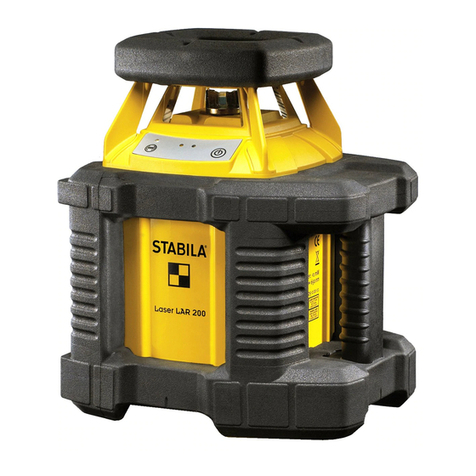
Stabila
Stabila LAR-200 User manual
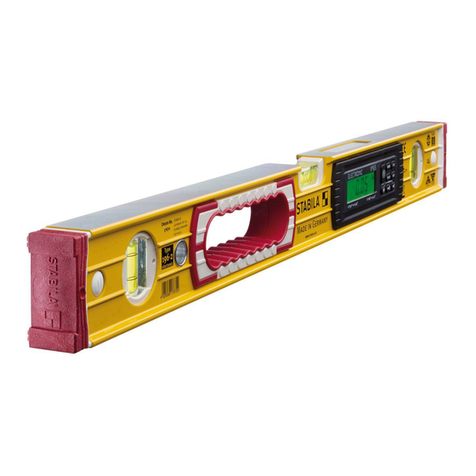
Stabila
Stabila TECH 196-2 Electronic Series User manual
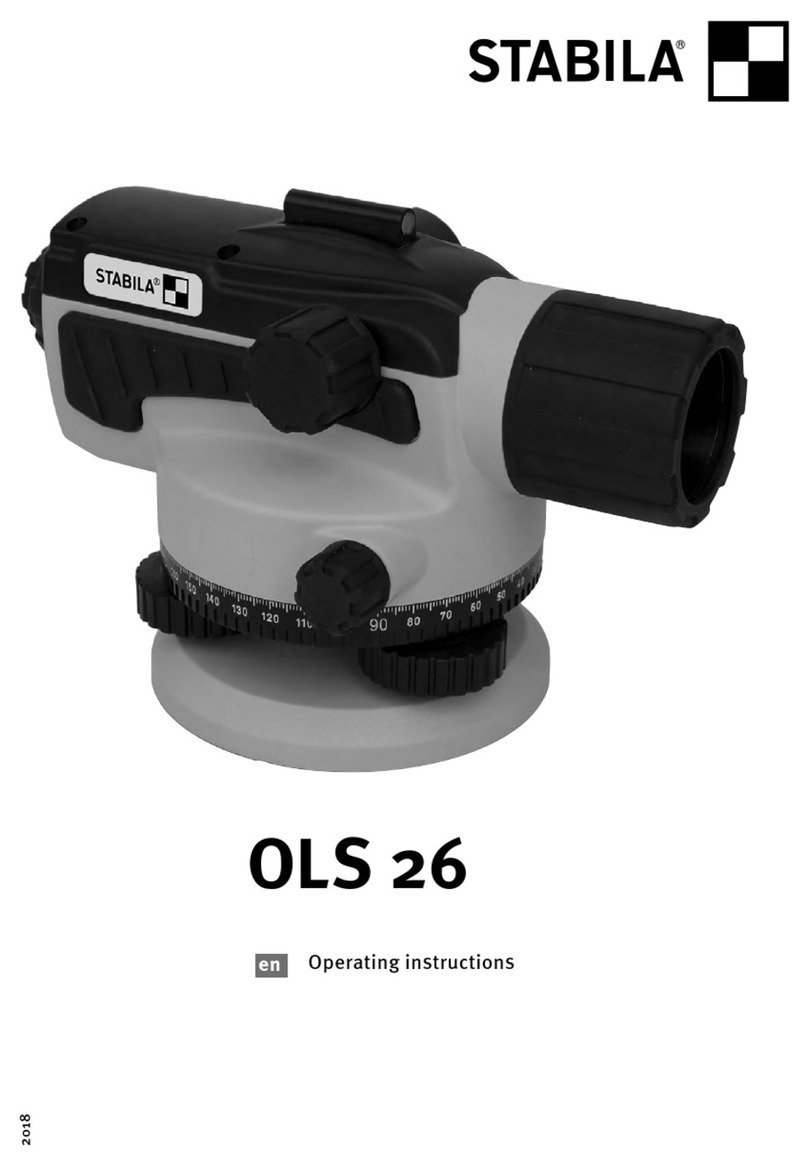
Stabila
Stabila OLS 26 User manual
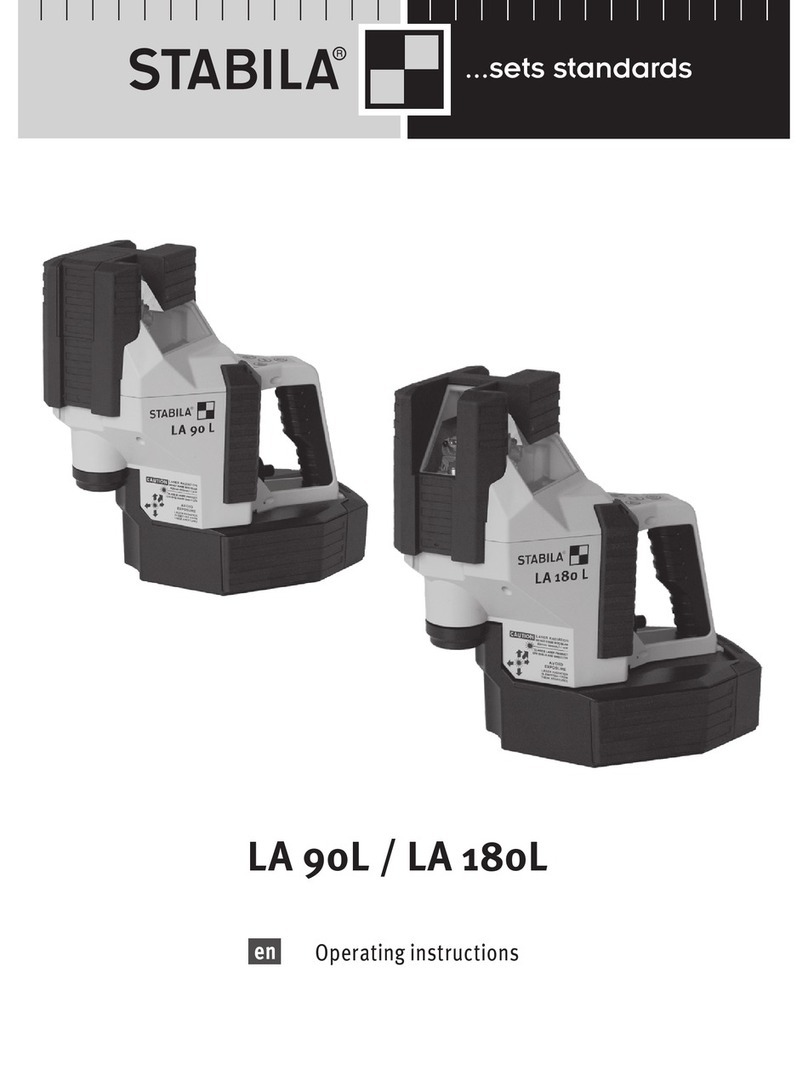
Stabila
Stabila LA 90L User manual

Stabila
Stabila LAX 300 G User manual
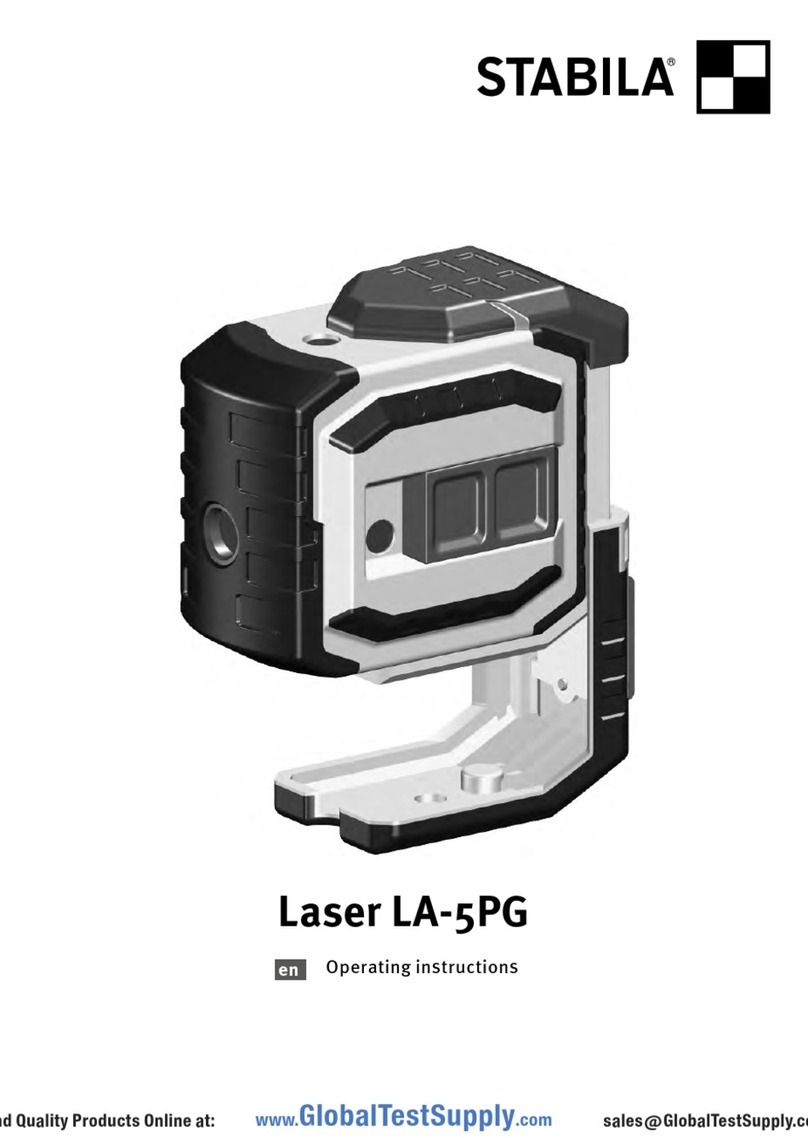
Stabila
Stabila LA-5PG User manual
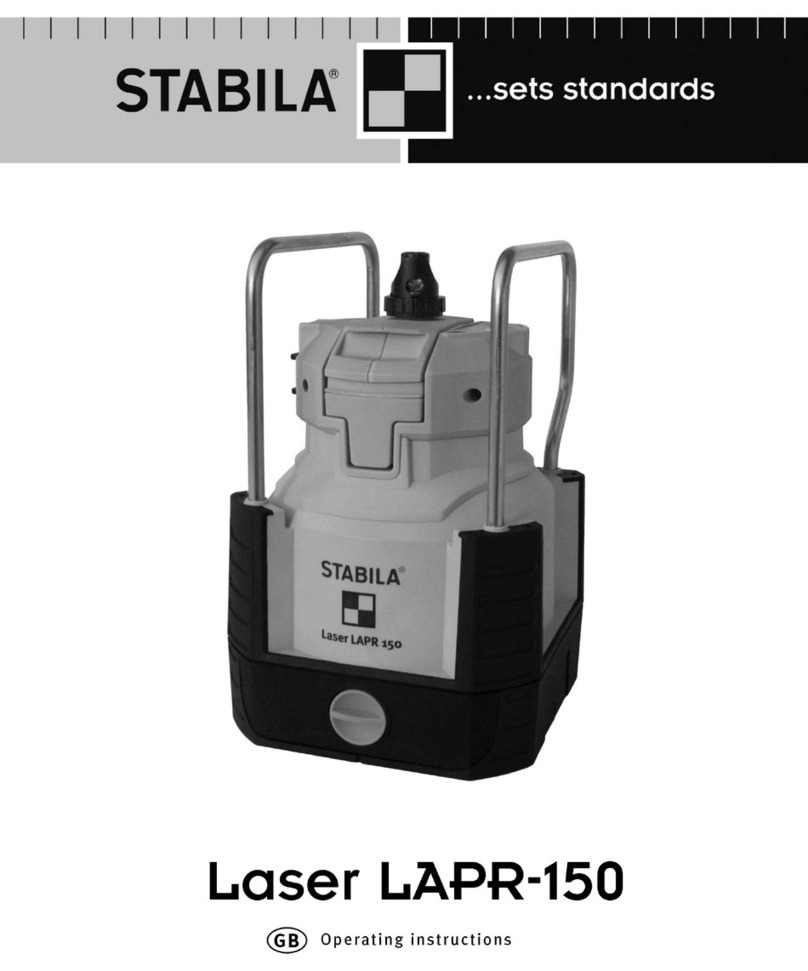
Stabila
Stabila LAPR-150 User manual

Stabila
Stabila Laser FLS 90 User manual

Stabila
Stabila LA-4P User manual
Popular Laser Level manuals by other brands
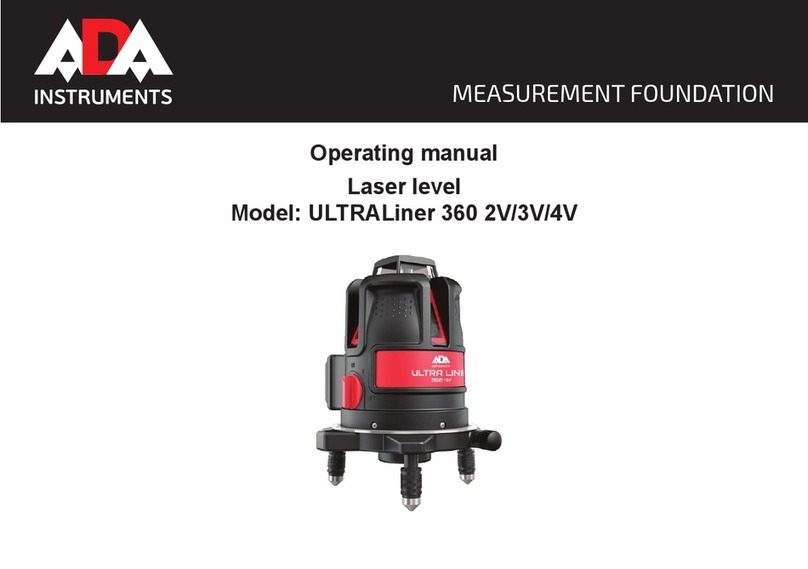
ADA INSTRUMENTS
ADA INSTRUMENTS ULTRALiner 360 2V operating manual
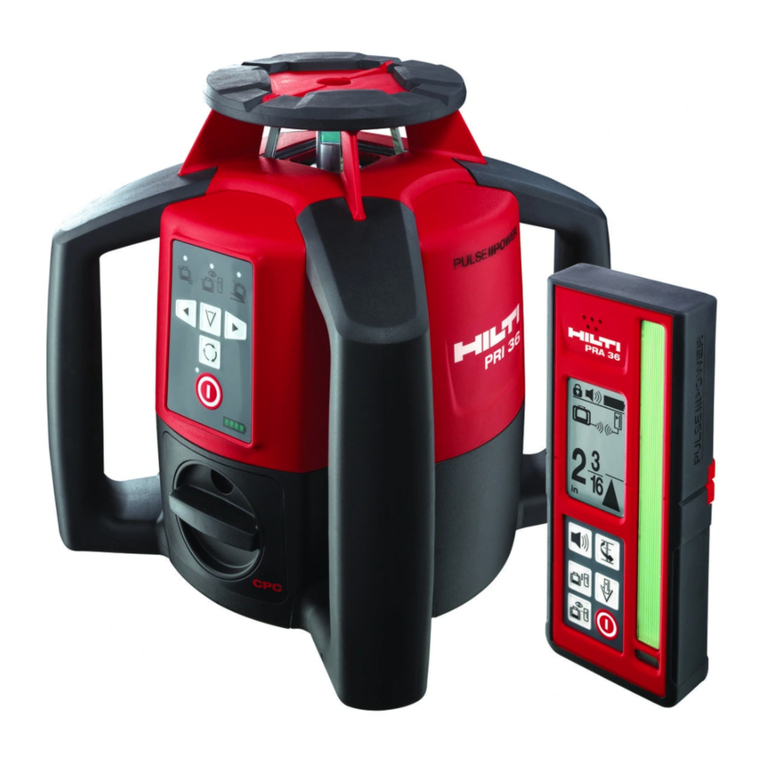
Hilti
Hilti PRI 36 operating instructions
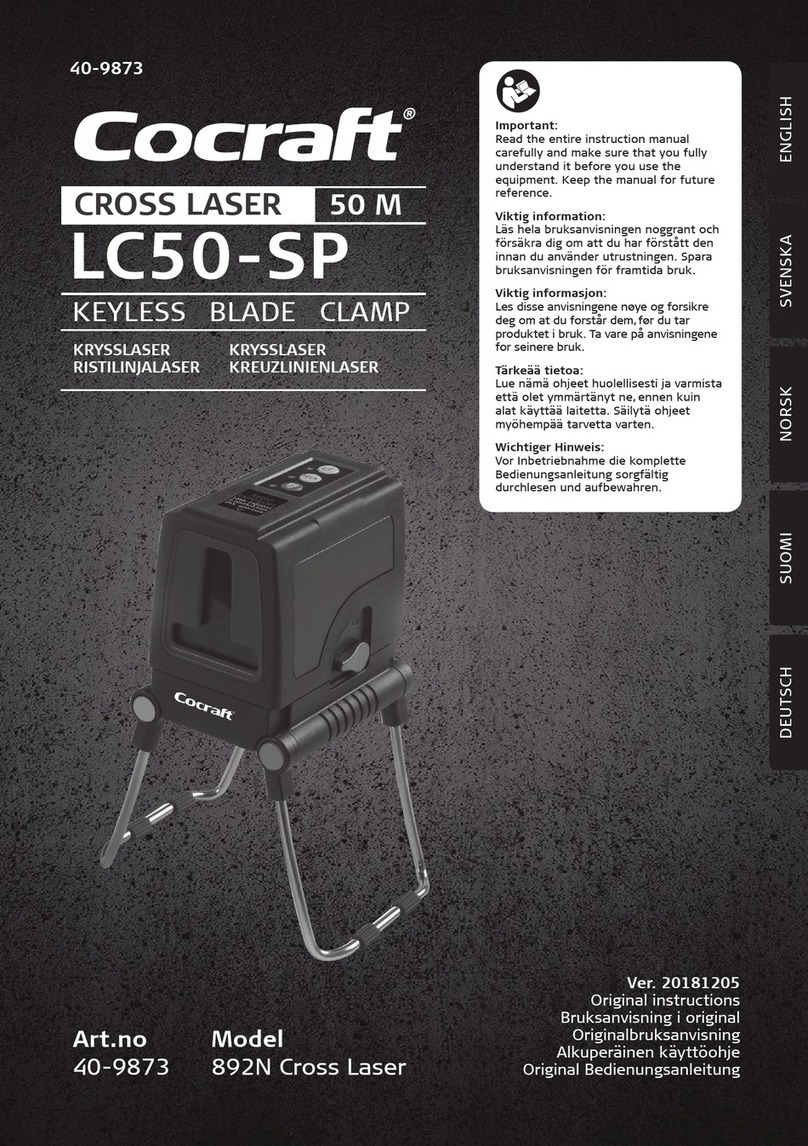
Cocraft
Cocraft CROSS LASER LC50-SP Original instructions
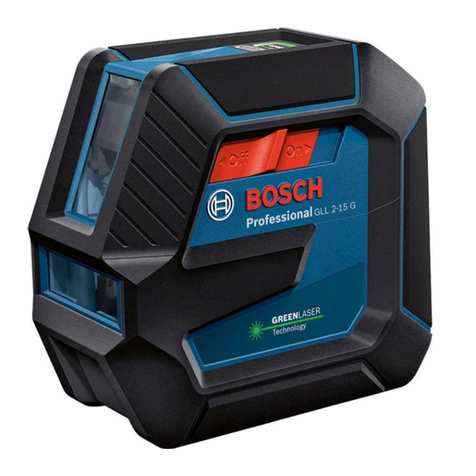
Bosch
Bosch Professional GLL 2-15 G Original instructions
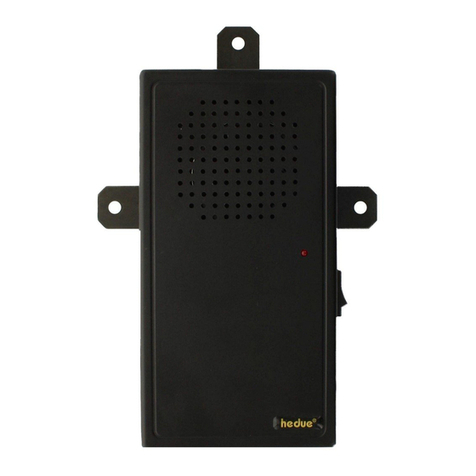
Hedue
Hedue M420 operating instructions
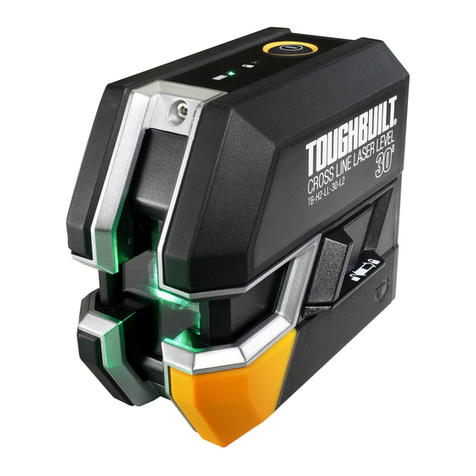
TOUGHBUILT
TOUGHBUILT TB-H2-LL-30-L2 Operating/safety instructions
